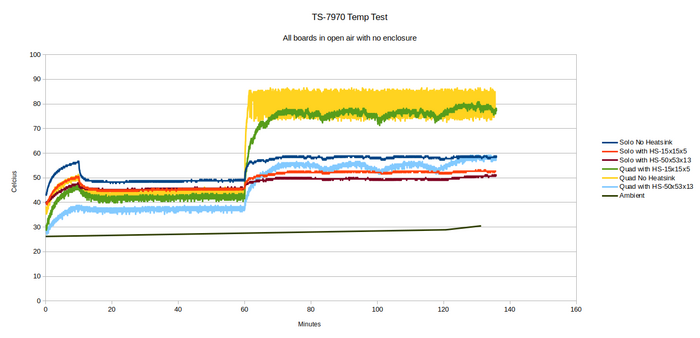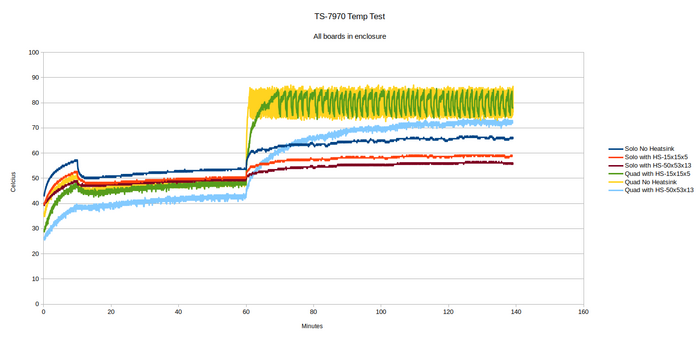TS-7970 Specifications: Difference between revisions
| Line 149: | Line 149: | ||
The TS-7970 generates all rails from either the 8-28VDC input, or the 5V input. This table does not document every rail. This will only cover those that can provide power to an external header for use in an application. | The TS-7970 generates all rails from either the 8-28VDC input, or the 5V input. This table does not document every rail. This will only cover those that can provide power to an external header for use in an application. | ||
5V will | Direct 5V input will bypass our regulator, but the absolute max a supply can provide 5A to the board. | ||
{| class=wikitable | {| class=wikitable | ||
Revision as of 11:52, 13 February 2017
Power Specifications
The TS-7970 includes 2 methods for powering the board. There is a 5V input, and a 8-28V input. Only one of these should be provided to the board.
| Input | Min voltage | Max voltage |
|---|---|---|
| 5V input | 4.75 | 5.25 |
| 8-28V Input | 8.00 | 28.00 |
Power Consumption
The i.MX6 power consumption can vary a lot depending on the build and activity of the board. Most of the power savings happens automatically when the CPU and GPU are idle. It is also possible to disable the Ethernet PHY for extra savings.
# Put ETH PHY in reset
echo 116 > /sys/class/gpio/export
echo high > /sys/class/gpio/gpio116/direction
# Put USB HUB in reset
echo 43 > /sys/class/gpio/export
echo low > /sys/class/gpio/gpio43/direction
Ethernet is not connected unless otherwise specified. Serial is disconnected during the measurement. The CPU test is 5x processes of "openssl speed". The GPU test is Qt5CinematicExperience in the Yocto image.
These tests are performed powering the board through 5V.
| Test | Max Watts | Average Watts |
|---|---|---|
| CPU 100% + GPU loaded (LCD 100%) + IO + Ethernet + HDMI | 4.50 (0.90 A) | 3.40 (0.68 A) |
| CPU 100% | 2.80 (0.56 A) | 2.35 (0.47 A) |
| CPU Idle + HDMI | 2.75 (0.55 A) | 2.05 (0.41 A) |
| CPU Idle + CPU Ethernet | 2.75 (0.55 A) | 2.20 (0.44 A) |
| CPU Idle | 2.50 (0.50 A) | 1.95 (0.39 A) |
| CPU Idle USB HUB off | 2.75 (0.55 A) | 1.95 (0.39 A) |
| CPU Idle USB HUB off, Ethernet PHY in reset | 2.15 (0.43 A) | 1.60 (0.32 A) |
| Using onboard uC to sleep CPU | 0.025 (125 mA) | 0.022 (4.4 mA) |
| Test | Max Watts | Average Watts |
|---|---|---|
| CPU 100% + GPU loaded (LCD 100%) + IO + Ethernet + HDMI | 10.80 (2.16 A) | 7.75 (1.55 A) |
| CPU 100% | 6.15 (1.23 A) | 5.40 (1.08 A) |
| CPU Idle + HDMI | 4.55 (0.91 A) | 2.90 (0.58 A) |
| CPU Idle + WIFI on wpa2 running iperf | 6.85 (1.37 A) | 3.95 (0.79 a) |
| CPU Idle + CPU Ethernet | 5.00 (1.00 A) | 3.10 (0.62 A) |
| CPU Idle + PCIe Ethernet | 3.60 (0.72 A) | 2.85 (0.57 A) |
| CPU Idle | 4.85 (0.97 A) | 2.80 (0.56 A) |
| CPU Idle USB HUB off | 3.50 (0.70 A) | 2.75 (0.55 A) |
| CPU Idle USB HUB off, Ethernet PHY in reset | 3.30 (0.66 A) | 2.40 (0.48 A) |
| Using onboard uC to sleep CPU | 0.025 (125 mA) | 0.022 (4.4 mA) |
Temperature Specifications
There are a few different models which will have different operating temperatures:
| Model Number | Operating Min | Cooling Temp | Passive Temp | Critical Temp |
|---|---|---|---|---|
| TS-7970-*S8S* | -40C | 75C | 85C | 105C |
| TS-7970-*Q10S* | -20C | 75C | 85C | 100C |
These are also exposed in /sys/:
# Passive
cat /sys/devices/virtual/thermal/thermal_zone0/trip_point_0_temp
# Critical
cat /sys/devices/virtual/thermal/thermal_zone0/trip_point_1_temp
You can view the CPU die temp with:
cat /sys/devices/virtual/thermal/thermal_zone0/temp
When the CPU heats up past the cooling temp on a first boot, it will take no action. Heating up past the passive temperature the kernel will cool down the CPU by reducing clocks. This will show a kernel message:
[ 158.454693] System is too hot. GPU3D will work at 1/64 clock.
If it cools back down below the cooling temperature it will spin back up the clocks.
[ 394.082161] Hot alarm is canceled. GPU3D clock will return to 64/64
If it continues heating to the critical temperature it will overheat and reboot. Booting back up u-boot will block the boot until the temperature has been reduced to the Cooling Temp+5C. This will be shown on boot with:
U-Boot 2015.04-07857-g486fa69 (Jun 03 2016 - 12:04:30) CPU: Freescale i.MX6SOLO rev1.1 at 792 MHz CPU Temperature is 105 C, too hot to boot, waiting... CPU Temperature is 102 C, too hot to boot, waiting... CPU Temperature is 99 C, too hot to boot, waiting... CPU Temperature is 90 C, too hot to boot, waiting... CPU Temperature is 86 C, too hot to boot, waiting... CPU Temperature is 84 C, too hot to boot, waiting... CPU Temperature is 80 C, too hot to boot, waiting... CPU Temperature is 80 C, too hot to boot, waiting... CPU Temperature is 80 C, too hot to boot, waiting... CPU: Temperature 78 C Reset cause: WDOG Board: TS-7970
These temperature tests show the TS-7970 with/without both the heatsink and enclosure.
Our testing has also shown an estimate how how high a board will be over ambient in open air.
| Configuration | Temp range over ambient |
| Solo No Heatsink | 21-27C |
| Solo with Heatsink | 18C |
| Quad No Heatsink | 16-50C |
| Quad with Heatsink | 10-23C |
IO Specifications
The GPIO external to the board are all nominally 3.3V, but will vary depending on if they are CPU/FPGA pins.
The CPU pins can be adjusted in software and will have initial values in the device tree. This lets you adjust the drive strength, and pull strength of the IO. See the device tree for your kernel for further details on a specific IO.
The FPGA IO cannot be adjusted further in software.
| IO | Typical Range | Absolute Range | Logic Low | Logic high | Drive strength |
|---|---|---|---|---|---|
| External CPU GPIO | 0-3.3V | -0.5V to 3.3V Rail + 0.3V | 0.3 * 3.3V Rail | 0.7 * 3.3V Rail | 27.5mA |
| External FPGA GPIO | 0.3.3V | -0.5-3.75V | 0.8 | 2.0 | 12mA |
Refer to the MachXO Family Datasheet for more detail on the FPGA IO. Refer to the CPU quad or solo datasheet for further details on the CPU IO.
| WARNING: | Do not drive any IO from an external supply until 3.3V is up on the board. Doing so can violate the power sequencing of the board causing failures. |
Rail Specifications
The TS-7970 generates all rails from either the 8-28VDC input, or the 5V input. This table does not document every rail. This will only cover those that can provide power to an external header for use in an application.
Direct 5V input will bypass our regulator, but the absolute max a supply can provide 5A to the board.
| Rail | Current Available | Location |
|---|---|---|
| 3.3V | 200mA [1] | HD1 pin 23, HD2 pin 23, mPCIe, HD3 pin 3 |
| 5V | Quad core 2A, Solo 3A [2] | HD1 pins 15/16, HD3 pin 6, USB, mPCIe |

